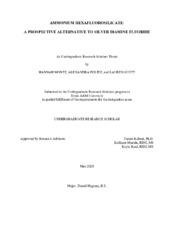Ammonium Hexafluorosilicate: A Prospective Alternative to Silver Diamine Fluoride
Abstract
According to the 2015 National Health and Nutrition Examination Survey, one in every seven United States children, between the ages two and eight, have untreated dental caries. Arresting dental caries is critical within the primary dentition to prevent further complications in permanent tooth development. Recent research suggests silver diamine fluoride (SDF) is an increasingly popular method for arresting dental caries in pediatric patients. However, SDF precipitates an irreversible black stain due to formation of silver oxide. Ammonium hexafluorosilicate (AHF) is an innovative approach to arresting dental caries and treating dentinal hypersensitivity without the effect of staining due to the use of silica instead of silver. Research has shown that AHF elicits calcium phosphate precipitation and dentinal tubule occlusion. Therefore, AHF could be an effective treatment for dentinal hypersensitivity and arresting dental caries. Cytotoxicity tests have been conducted to evaluate cell cultures enzyme activities, membrane integrity, alteration of cell morphology and cell growth inhibition using concentrations ranging from 0.001%-1%. Concentrations of AHF ranging from 0.1%-1.0% have generated significant loss (p<0.05) of human gingival fibroblasts (hGFs); however, lower SDF concentrations of 0.01%-1.0% promoted similar significant losses of hGFs. Until further research is completed, the cytotoxicity of AHF appears to be acceptable for gingival tissue use at concentrations of 0.001%-0.01%, especially when compared to the cytotoxicity of SDF being acceptable at concentrations of 0%-0.005% on hGFs. In conclusion, in-vivo studies are needed to determine the clinical efficacy and long-term effects of AHF as a potential product to treat dental caries and dentinal hypersensitivity without the negative aspects of staining.
Subject
Ammonium HexafluorosilicateCaries Arrest
Cytotoxicity
Dentinal Hypersensitivity
Silver Diamine Fluoride
Staining
Citation
Politz, Alexandra Renee; Scott, Lauren; Montz, Hannah (2020). Ammonium Hexafluorosilicate: A Prospective Alternative to Silver Diamine Fluoride. Undergraduate Research Scholars Program. Available electronically from https : / /hdl .handle .net /1969 .1 /189278.


